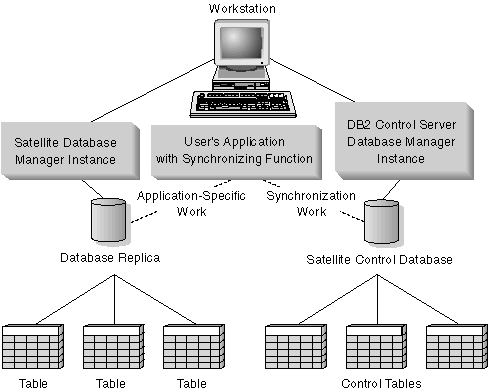

To build a synchronizing application for the satellite environment, you can use either the DB2 Personal Developer's Edition, or the DB2 Universal Developer's Edition. Either product includes the tools that you need to build applications that run on the Windows 32-bit operating systems.
| Note: | Neither of these products is available from the DB2 Satellite Edition CD. You can obtain them from a different DB2 Universal Database product CD. For information on how to install either product, refer to the Quick Beginnings for the DB2 Universal Database product that you have. |
Figure 5 shows one method in which the synchronizing application that you build can interface with the database on the satellite and the satellite control database on the DB2 control server in a development environment. You can contrast this possible development configuration with how the satellite synchronizes in a production environment, which is shown in Figure 2. The development environment shown in Figure 5 includes the following:
| Note: | The DB2 SDK is not available from the DB2 Satellite Edition CD. You can, however, install the DB2 SDK from a different DB2 Universal Database product CD onto the satellite. |
Figure 5. Synchronizing Application Program
 |
When building applications, you can find relevant information in the following books that are provided with DB2 Universal Database:
| Note: | The APIs for synchronization are available in C only. |
For problem determination information that is specific to the satellite environment, see Chapter 11, Problem Determination.
When building your applications, you can use a variety of tools to write and test the SQL statements in your applications, and to monitor their performance. You can use the Satellite Administration Center to both set up and administer the satellite environment. You use the DB2 Synchronizer application to both test and validate the set up of the satellite environment.
The sections that follow provide information that is specific to setting up the development environment, and building an application for the satellite environment.
[ Top of Page ]